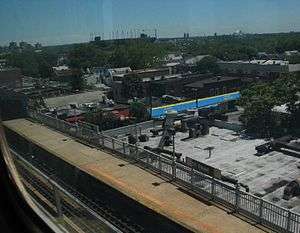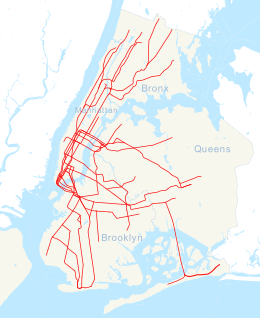111th Street station (IRT Flushing Line)
111th Street is a local station on the IRT Flushing Line of the New York City Subway, located at the intersection of 111th Street and Roosevelt Avenue.[3] It is served by the 7 train at all times.[4]
111 Street | |||||||
|---|---|---|---|---|---|---|---|
 A view of the platform as seen from an express train on the flyover track. | |||||||
| Station statistics | |||||||
| Address | 111th Street & Roosevelt Avenue Queens, NY 11368 | ||||||
| Borough | Queens | ||||||
| Locale | Corona | ||||||
| Coordinates | 40°45′6.17″N 73°51′20.29″W | ||||||
| Division | A (IRT) | ||||||
| Line | IRT Flushing Line | ||||||
| Services | 7 | ||||||
| Transit connections | |||||||
| Structure | Elevated | ||||||
| Platforms | 2 side platforms | ||||||
| Tracks | 5 (2 local in passenger service at platform level; 1 express track above) | ||||||
| Other information | |||||||
| Opened | October 13, 1925 | ||||||
| Station code | 449[1] | ||||||
| Opposite-direction transfer available | Yes | ||||||
| Traffic | |||||||
| Passengers (2019) | 3,836,999[2] | ||||||
| Rank | 129 out of 424[2] | ||||||
| Station succession | |||||||
| Next north | Mets–Willets Point: 7 | ||||||
| Next south | 103rd Street–Corona Plaza: 7 | ||||||
| |||||||
| |||||||
| |||||||
History

The station was opened on October 13, 1925,[5] with shuttle service between 111th Street and the previous terminal at Alburtis Avenue (now 103rd Street–Corona Plaza).[6] Shuttle service used the Manhattan-bound track.[7] The line was extended to Willets Point Boulevard (now Mets–Willets Point) on May 7, 1927,[8] and to the current terminal at Flushing–Main Street on January 21, 1928.[9]
The platforms at 111th Street were extended in 1955–1956 to accommodate 11-car trains.[10]
As part of the 2015–2019 Capital Program, the MTA would renovate the 52nd, 61st, 69th, 82nd, 103rd and 111th Streets stations, a project that has been delayed for several years but is slated to begin in mid-2020. Conditions at these stations were among the worst of all stations in the subway system.[11]
Station layout
| 3F | Peak-direction express | ← |
| 2F Platform level |
Side platform | |
| Southbound local | ← | |
| Yard lead | No regular service | |
| Yard lead | No regular service | |
| Northbound local | | |
| Side platform | ||
| 1F | Mezzanine | Fare control, station agent, MetroCard machines |
| G | Street level | Entrances/exits |
The station has five tracks and two side platforms. The express track is located on a flyover above the other four tracks. The two center tracks are not used in passenger service, but instead are used as yard leads of the Corona Yard, where 7 trains are maintained and stored. As a result, trains that go to/from the yard often terminate or begin at this station.[12][13][14] Stations with flyover express tracks such as this were far more common on IRT elevated lines in Manhattan during the 19th and early 20th centuries. Due to the yard tracks, an unusual layout takes place in and east of the station. The two layup tracks only have connections to the main tracks east of the station. The eastbound track rises east of the station while the express track lowers. The layup tracks dive down and cross under the eastbound track. The westbound track then rises to level out the three tracks, which continue east.[15]
This station has full windscreens except at the west end of the eastbound platform, which has a waist-high steel fence instead.
Exits
Exit is at the south (geographic west) end, with staircases to all four corners of 111th Street and Roosevelt Avenue.[13][3] The mezzanine and stairway landings are wooden while the flooring at the fare control area is concrete.[16] The station has a crossunder between platforms. New signs have covered the old ones. Above some of the black station signs reading "111 Street" are white signs reading "Hall of Science", identifying the nearby New York Hall of Science five blocks south.[3][13][17][18]
References
- "Station Developers' Information". Metropolitan Transportation Authority. Retrieved June 13, 2017.
- "Facts and Figures: Annual Subway Ridership 2014–2019". Metropolitan Transportation Authority. 2020. Retrieved May 26, 2020.
- "MTA Neighborhood Maps: Corona" (PDF). mta.info. Metropolitan Transportation Authority. 2018. Retrieved October 1, 2018.
- "7 Subway Timetable, Effective April 6, 2020". Metropolitan Transportation Authority. Retrieved August 18, 2020.
- State of New York - Transit Commission (1926). Fifth annual report for the calendar year 1925 (Report). Albany, N.Y.: J.B. Lyon Company. pp. 86.
- "First Trains to be Run on Flushing Tube Line Oct. 13: Shuttle Operation Ordered to 111th Street Station on New Extension". Newspapers.com. Brooklyn Daily Eagle. October 5, 1925. p. 8. Retrieved September 20, 2015.
- Poor's Public Utility Section 1925. New York: Poor's Publishing Co. 1925. p. 523.
- "Corona Subway Extended; New Service Goes to Within 350 Feet of Flushing Creek Bridge". The New York Times. May 8, 1927. p. 26. Retrieved September 26, 2009.
- "Flushing Rejoices as Subway Opens; Service by B.M.T. and I.R.T. Begins as Soon as Official Train Makes First Run. Hope of 25 Years Realized Pageant of Transportation Led by Indian and His Pony Marks the Celebration. Hedley Talks of Fare Rise. Transit Modes Depicted" (PDF). The New York Times. January 22, 1928. Retrieved September 18, 2015.
- Minutes and Proceedings. New York City: New York City Transit Authority. 1955.
- "MTA To Overhaul Six Stations on the 7 Line, Currently in Design Phase". Sunnyside Post. November 19, 2019. Retrieved April 29, 2020.
- Marrero, Robert (January 1, 2017). "472 Stations, 850 Miles" (PDF). B24 Blog, via Dropbox. Retrieved April 27, 2018.
- Cox, Jeremiah. "111 Street (7) - The SubwayNut". www.subwaynut.com. Retrieved February 18, 2016.
- "www.nycsubway.org: IRT Flushing Line". www.nycsubway.org. Retrieved February 18, 2016.
- Dougherty, Peter (2006) [2002]. Tracks of the New York City Subway 2006 (3rd ed.). Dougherty. OCLC 49777633 – via Google Books.
- "7 Train". Station Reporter. August 11, 2014. Archived from the original on August 11, 2014. Retrieved February 18, 2016.
- Harpaz, Beth J. (April 10, 2014). "Revisiting NYC's 1964 World's Fair, 50 years later". San Diego Union Tribune. Associated Press. Archived from the original on April 6, 2020.
- Browne, Malcolm W. (September 5, 1986). "City Again Boasts a Science Museum". The New York Times. p. C-21. Archived from the original on May 24, 2015.
External links
| Wikimedia Commons has media related to 111th Street (IRT Flushing Line). |
- nycsubway.org – IRT Flushing Line: 111th Street
- Station Reporter — 7 Train
- The Subway Nut — 111th Street Pictures
- 111th Street entrance from Google Maps Street View
- Platforms from Google Maps Street View



%26groups%3D_086748e9981320be77bb4e16402c88207eea5ac0.svg)